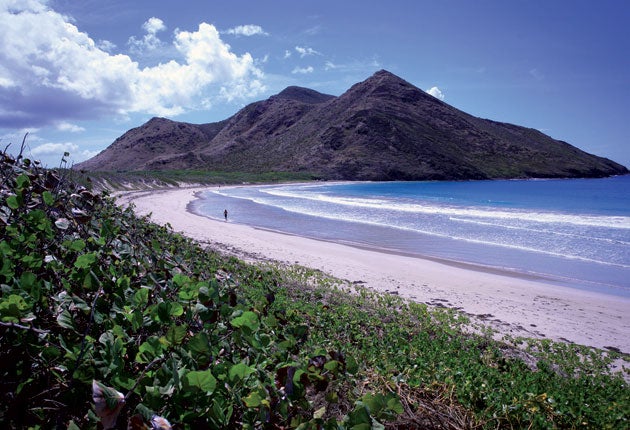Change is coming to St Kitts
This Caribbean island has big plans to woo the tourists. Nina Lakhani reports

Your support helps us to tell the story
From reproductive rights to climate change to Big Tech, The Independent is on the ground when the story is developing. Whether it's investigating the financials of Elon Musk's pro-Trump PAC or producing our latest documentary, 'The A Word', which shines a light on the American women fighting for reproductive rights, we know how important it is to parse out the facts from the messaging.
At such a critical moment in US history, we need reporters on the ground. Your donation allows us to keep sending journalists to speak to both sides of the story.
The Independent is trusted by Americans across the entire political spectrum. And unlike many other quality news outlets, we choose not to lock Americans out of our reporting and analysis with paywalls. We believe quality journalism should be available to everyone, paid for by those who can afford it.
Your support makes all the difference.The only sounds to be heard along the coast road of St Kitts on Sunday mornings are the waves and the devout. Gospel songs radiate from the scores of churches found across this small East Caribbean island of just 32,000 people, where Sunday is still a day of rest. "If you live with mama, then you go to church," says my guide, Lisa. "That's not going to change for a long time."
But change is coming to St Kitts. Last month, British Airways launched a new weekly direct flight that will make the island and its even smaller sister nation, Nevis, more accessible to British holidaymakers. Also, by 2011, Christophe Harbour, a 2,500-acre development, will transform St Kitts' south-eastern peninsula into a formidable tourist hub.
The most ambitious of six new developments slated for the island, this luxury resort will centre on a mega-yacht marina and feature two five-star hotels, including a 125-room Mandarin Oriental, exclusive shops and restaurants. US basketball legend Michael Jordan is reported to have bought one of the plots of land overlooking Sand Bank Bay that carry a price tag of around $3m.
The resort will be spread across 13 miles of pristine coastline, including seven beaches. The marina and harbour village will be the centre, with moorings for 250 boats, including slips big enough for 300ft mega-yachts. Two beach clubs, tennis courts, deep-sea fishing, turtle watching, and a championship golf course will be part of the exclusive experience.
Despite the global recession, the development shows no sign of slowing down. It will create at least 2,000 new jobs; 80 per cent of those are expected to go to Kittitians. The government is committed to ensuring the architecture, size and density of all new buildings will have a minimal impact on the landscape. Ministers are also considering proposals to designate Sandy Bank Bay a marine sanctuary to protect the sea turtles that return each year to breed.
For now, visitors to the islands are presented with simpler pleasures. On the coast, where the sands turn from powdery white to volcanic black, bathers can choose from the calm Caribbean and wilder Atlantic. In the fertile interior, hikers can climb through rainforest to reach the 3,792ft summit of Mount Liamuiga, where a wide crater provides a perch from which to enjoy the views of neighbouring islands.
A less arduous way to explore the island is on the Sugar Train, a scenic railway that rides on tracks built to transport sugar. It passes beneath the impressive 17th-century Brimstone Hill Fortress, which encapsulates the island's colonial history. This Unesco world heritage site was built by slaves for the British to guard against French invasion. The two powers battled for 130 years before Britain gained control in 1713, ruling until independence in 1983.
Another diversion for visitors to St Kitts is a stopover in Nevis, a 15-minute hop by air or water taxi, or 30 minutes by ferry. If St Kitts is small and peaceful, then Nevis is tiny and serene; with around 11,000 inhabitants, the pace here grinds almost to a halt. Nevis has its fair share of beautiful beaches and a lush interior to explore in the shadow of its volcanic peak, but this island is all about plantations. Its well-preserved estates have been put to use as luxurious hotels for the mainly older visitors who come here for sunny days and early nights with a colonial twist.
But change is coming to this island too. There's much talk about eco-projects, though firm plans are hard to come by. One that is in progress is a geothermal energy plant. It's the first in the east Caribbean and is set to make the island self-sufficient in electricity by next year.
"Nevis has the best geothermal potential I've ever seen," says Kerry McDonald, engineer and chief executive of West Indies Power. "We don't have to drill too deep and there are no mineral by-products to deal with. It's like we've struck gold."
The plant will be able to supply electricity to St Kitts from 2011, and other islands are expressing interest. Locals are being trained, which would encourage young islanders to stay. Other sustainable projects include cotton and there has been a resurgence in small-scale farming. Like its sister St Kitts, this backwater is embracing the 21st century.
Compact facts
How to get there
Nina Lakhani travelled to St Kitts and Nevis with British Airways Holidays (0844 493 0758; ba.com), which offers seven nights at the Marriott on St Kitts and seven nights at the Montpelier Plantation on Nevis from £1,689 per person, including return BA flights from Gatwick, room only at the Marriott, and B&B at the Montpelier Plantation.
Further information
St Kitts Tourism Authority (020-7376 0881; stkittstourism.kn).
Join our commenting forum
Join thought-provoking conversations, follow other Independent readers and see their replies
Comments